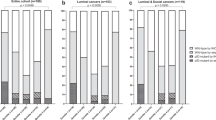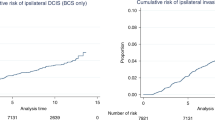Abstract
The management of precancerous lesions of the breast has become a considerable clinical problem in the past 20 years, mostly as a consequence of increased detection due to the introduction of mammographic screening. It is not possible to identify with absolute certainty which of these lesions will progress to invasive carcinoma, and tailoring the treatment according to each individual case remains a challenge. There is a particular dilemma for surgeons, who must balance the risk of resecting too much and causing unnecessary cosmetic damage, or resecting too little and leaving an increased risk of recurrence. Further knowledge in the field of predictive and prognostic factors together with the development of gene-profiling techniques will, hopefully, provide answers to these questions. Among precancerous lesions of the breast, particular attention should be paid to ductal carcinoma in situ or intraductal carcinoma, appropriate treatment of which is crucial to prevent invasive breast cancer. Nearly all possible combinations of surgery, radiotherapy and medical treatments (anti-estrogens) have been tested in different clinical trials, but the situation is far from satisfactory. We believe that an important contribution can come from oncoplastic surgery, which is the application of plastic and reconstructive surgical techniques to ensure both radical excision of the disease and acceptable cosmetic outcomes.
Key Points
-
Precancerous lesions of the breast are increasingly diagnosed as a consequence of the introduction of mammographic screening
-
We are still unable to identify which of these lesions will progress to invasive carcinoma,leading to a consequent constant risk of overtreatment or undertreatment
-
Described biomarkers to monitor the progression to invasive cancer include estrogen receptors, p53, HER2, Ki-67, vascular endothelial growth factor and bcl-2 oncoprotein
-
Different combinations of surgery, radiotherapy and medical treatments have been tested without satisfactory results
-
Cosmesis-oriented surgical techniques (i.e. oncoplastic breast surgery) seem to be the methods most likely to become the gold standard treatment of these lesions
This is a preview of subscription content, access via your institution
Access options
Subscribe to this journal
Receive 12 print issues and online access
$209.00 per year
only $17.42 per issue
Buy this article
- Purchase on Springer Link
- Instant access to full article PDF
Prices may be subject to local taxes which are calculated during checkout
Similar content being viewed by others
References
Sewell CW (2004) Pathology of high-risk breast lesions and ductal carcinoma in situ. Radiol Clin North Am 42: 821–830
Jacobs TW et al. (2002) Nonmalignant lesions in breast core needle biopsies: to excise or not to excise? Am J Surg Pathol 26: 1095–1110
Morrow M (2004) The certainties and uncertainties of ductal carcinoma in situ. J Natl Cancer Inst 96: 424–425
Schreer I and Luttges J (2005) Precursor lesions of invasive breast cancer. Eur J Radiol 54: 62–71
Mulligan AM and O'Malley FP (2007) Papillary lesions of the breast: a review. Adv Anat Pathol 14: 108–119
Mercado CL et al. (2006) Papillary lesions of the breast at percutaneous core-needle biopsy. Radiology 238: 801–808
Krishnamurthy S and Sneige N (2002) Molecular and biologic markers of premalignant lesions of human breast. Adv Anat Pathol 9: 185–197
Stoll BA (1999) Premalignant breast lesions: role for biological markers in predicting progression to cancer. Eur J Cancer 35: 693–697
Allred DC and Mohsin SK (2000) Biological features of human premalignant breast disease. In: Diseases of the Breast (Ed. Harris R) Philadelphia: Lippincott Williams & Wilkins
Veronesi U et al. (1998) Prevention of breast cancer with tamoxifen: preliminary findings from the Italian randomised trial among hysterectomised women. Italian Tamoxifen Prevention Study. Lancet 352: 93–97
Veronesi U et al. (2002) Tamoxifen for breast cancer among hysterectomised women. Lancet 359: 1122–1124
Veronesi U et al. (2007) Tamoxifen for the prevention of breast cancer: late results of the Italian Randomized Tamoxifen Prevention Trial among women with hysterectomy. J Natl Cancer Inst 99: 727–737
Lebeau A et al. (2003) EGFR, HER-2/neu, cyclin D1, p21 and p53 in correlation to cell proliferation and steroid hormone receptor status in ductal carcinoma in situ of the breast. Breast Cancer Res Treat 79: 187–198
Rudas M et al. (1997) p53 protein expression, cell proliferation and steroid hormone receptors in ductal and lobular carcinoma in situ carcinomas of the breast. Eur J Cancer 33: 39–44
Rudland PS (1993) Epithelial stem cells and their possible role in the development of the normal and diseased breast. Histol Histopathol 8: 385–387
Viacava P et al. (2004) Angiogenesis and VEGF expression in pre-invasive lesions of the human breast. J Pathol 204: 140–146
Viacava P et al. (2004) Angiogenesis and VEGF expression in pre-invasive lesions of the human breast. J Pathol 204: 140–146
Hyder SM (2006) Sex-steroid regulation of vascular endothelial growth factor in breast cancer. Endocr Relat Cancer 13: 667–687
Viacava P et al. (1999) Different proliferative patterns characterize different preinvasive breast lesions. J Pathol 188: 245–251
Mustonen M et al. (1997) The extent of apoptosis is inversely associated with bcl-2 expression in premalignant and malignant breast lesions. Histopathology 31: 347–354
Liberman L (2002) Percutaneous image-guided core breast biopsy. Radiol Clin North Am 40: 483–500
Liberman L et al. (2007) Underestimation of atypical ductal hyperplasia at MRI-guided 9-gauge vacuum-assisted breast biopsy. AJR Am J Roentgenol 188: 684–690
Ernster VL et al. (2000) Mortality among women with ductal carcinoma in situ of the breast in the population based Surveillance, Epidemiology and End Results Program. Arch Intern Med 160: 953–958
Ernster VL et al. (2002) Detection of ductal carcinoma in situ in women undergoing screening mammography. J Natl Cancer Inst 94: 1546–1554
Intra M et al. (2007) Radioguided localisation (ROLL) of non-palpable breast lesions and simultaneous sentinel lymph node biopsy (SNOLL): the experience of the European Institute of Oncology. Eur J Nucl Med Mol Imaging 34: 957–958
Baxter NN et al. (2004) Trends in the treatment of ductal carcinoma in situ of the breast. J Natl Cancer Inst 96: 443–448
Fisher B et al. (1993) Lumpectomy compared with lumpectomy and radiation therapy for the treatment of intraductal breast cancer. N Engl J Med 328: 1581–1586
Houghton J et al. (2003) UK Coordinating Committee on Cancer Research; Ductal carcinoma in situ working party; DCIS trialists in the UK, Australia and New Zealand: Radiotherapy and tamoxifen in women with completely excised ductal carcinoma in situ: randomized controlled clinical trial. Lancet 362: 95–102
Association of Breast Surgery at BASO, BAPRAS and the Training Interface Group in Breast Surgery et al. (2007) Oncoplastic breast surgery—a guide to good practice. Eur J Surg Oncol 33 (Suppl 1): S1–S23
Silverstein MJ et al. (1996) A prognostic index for ductal carcinoma in situ of the breast. Cancer 77: 2267–2274
Morrow M et al. (2000) DCIS and microinvasive carcinoma. In Diseases of the Breast. (Ed. Harris JR) Philadelphia: Lippincott Williams & Wilkins
Silverstein MJ et al. (1997) Breast irradiation is unnecessary for widely excised DCIS. Breast Cancer Res Treat 46: 23
Author information
Authors and Affiliations
Corresponding author
Ethics declarations
Competing interests
The authors declare no competing financial interests.
Rights and permissions
About this article
Cite this article
Costa, A., Zanini, V. Precancerous lesions of the breast. Nat Rev Clin Oncol 5, 700–704 (2008). https://doi.org/10.1038/ncponc1239
Received:
Accepted:
Published:
Issue Date:
DOI: https://doi.org/10.1038/ncponc1239
This article is cited by
-
The stress kinase MKK7 couples oncogenic stress to p53 stability and tumor suppression
Nature Genetics (2011)
-
High-risk lesions diagnosed at MRI-guided vacuum-assisted breast biopsy: can underestimation be predicted?
European Radiology (2011)
-
Precancerous lesions of the breast
Nature Reviews Clinical Oncology (2009)



